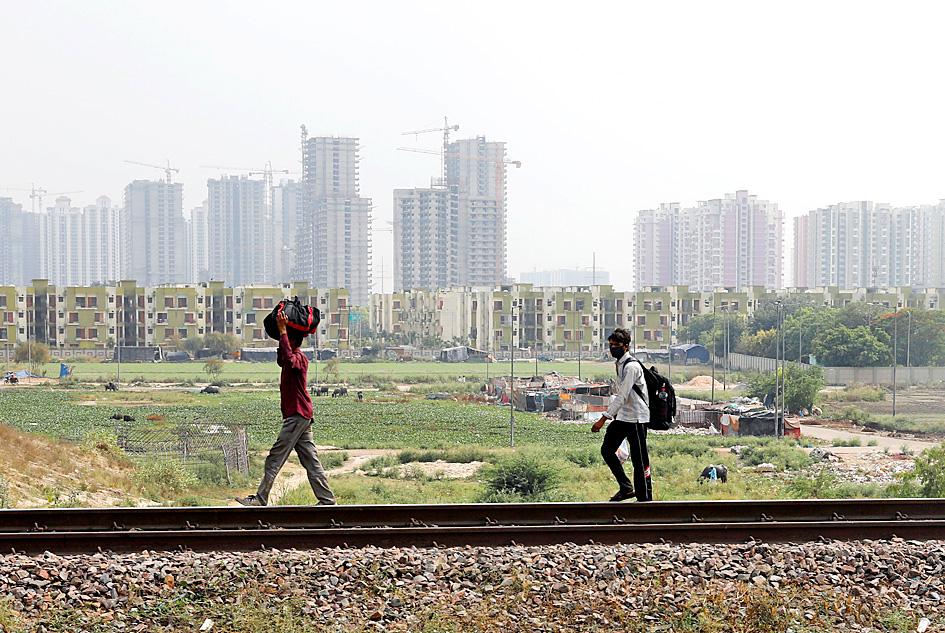The Indian government has pledged to spend US$265 billion, including US$40 billion in collateral-free loans to small businesses, to boost liquidity and help the economy weather the fallout of the COVID-19 pandemic.
The loans would benefit up to 4.5 million small businesses, Indian Minister of Finance Nirmala Sitharaman said in New Delhi yesterday.
“Essentially this is to spur growth and to build a very self-reliant India,” Sitharaman said. “It addresses ease of doing business, compliance and due diligence, and the intention is also to build local brands.”

Photo: Reuters
Indian Prime Minister Narendra Modi on Tuesday said that his government would spend an amount equivalent to 10 percent of the nation’s GDP to help the economy get back on its feet after weeks of stay-at-home restrictions to beat the pandemic.
The resultant halt to nonessential consumption set up Asia’s third-largest economy for its first annual contraction in four decades, as businesses collapsed and jobs were lost.
An estimated 122 million people lost their jobs last month, while consumer demand has evaporated.
Modi’s spending plan includes measures already unveiled by the government and by the Reserve Bank of India, such as the provision of cheap cash to banks and a reduction in its cash reserve ratio.
The details of the package are to be shared in tranches, Sitharaman said, adding that yesterday’s announcement covered 15 different measures, including six pertaining to small businesses, and that more would be announced over the next few days.
As part of the plan, small businesses would be eligible to borrow collateral-free automatic loans for a four-year tenor with a 12-month freeze on principal repayments. The loans would be guaranteed by the government.
“This economic package will be a crucial link in the creation of a self-reliant India,” Modi said. “It will focus on areas like land, labor, liquidity and law.”
Modi has come under criticism for the pain inflicted on India’s poor due to the sustained lockdown since the end of March.
In the past few days, the movement of millions of migrant workers from the cities where they had jobs to their homes in rural villages has dominated the news.
Companies have been urging the government for weeks to increase support measures.
Some restrictions were eased on April 20 to allow farmers and industries to resume operations in rural areas and in districts free of infection.
Still, companies are facing difficulties reopening factories because of travel restrictions, conflicting rules, broken supply chains and a shortage of workers.
The country has started running special trains to take stranded workers to their homes. Indian Railways also partially resumed passenger train operations from Tuesday, nearly two months after the services were stopped.

The US government has signed defense cooperation agreements with Japan and the Philippines to boost the deterrence capabilities of countries in the first island chain, a report by the National Security Bureau (NSB) showed. The main countries on the first island chain include the two nations and Taiwan. The bureau is to present the report at a meeting of the legislature’s Foreign Affairs and National Defense Committee tomorrow. The US military has deployed Typhon missile systems to Japan’s Yamaguchi Prefecture and Zambales province in the Philippines during their joint military exercises. It has also installed NMESIS anti-ship systems in Japan’s Okinawa

‘WIN-WIN’: The Philippines, and central and eastern European countries are important potential drone cooperation partners, Minister of Foreign Affairs Lin Chia-lung said Minister of Foreign Affairs Lin Chia-lung (林佳龍) in an interview published yesterday confirmed that there are joint ventures between Taiwan and Poland in the drone industry. Lin made the remark in an exclusive interview with the Chinese-language Liberty Times (the Taipei Times’ sister paper). The government-backed Taiwan Excellence Drone International Business Opportunities Alliance and the Polish Chamber of Unmanned Systems on Wednesday last week signed a memorandum of understanding in Poland to develop a “non-China” supply chain for drones and work together on key technologies. Asked if Taiwan prioritized Poland among central and eastern European countries in drone collaboration, Lin

Renewed border fighting between Thailand and Cambodia showed no signs of abating yesterday, leaving hundreds of thousands of displaced people in both countries living in strained conditions as more flooded into temporary shelters. Reporters on the Thai side of the border heard sounds of outgoing, indirect fire yesterday. About 400,000 people have been evacuated from affected areas in Thailand and about 700 schools closed while fighting was ongoing in four border provinces, said Thai Rear Admiral Surasant Kongsiri, a spokesman for the military. Cambodia evacuated more than 127,000 villagers and closed hundreds of schools, the Thai Ministry of Defense said. Thailand’s military announced that

CABINET APPROVAL: People seeking assisted reproduction must be assessed to determine whether they would be adequate parents, the planned changes say Proposed amendments to the Assisted Reproduction Act (人工生殖法) advanced yesterday by the Executive Yuan would grant married lesbian couples and single women access to legal assisted reproductive services. The proposed revisions are “based on the fundamental principle of respecting women’s reproductive autonomy,” Cabinet spokesperson Michelle Lee (李慧芝) quoted Vice Premier Cheng Li-chiun (鄭麗君), who presided over a Cabinet meeting earlier yesterday, as saying at the briefing. The draft amendment would be submitted to the legislature for review. The Ministry of Health and Welfare, which proposed the amendments, said that experts on children’s rights, gender equality, law and medicine attended cross-disciplinary meetings, adding that